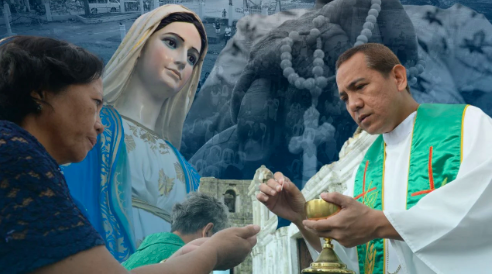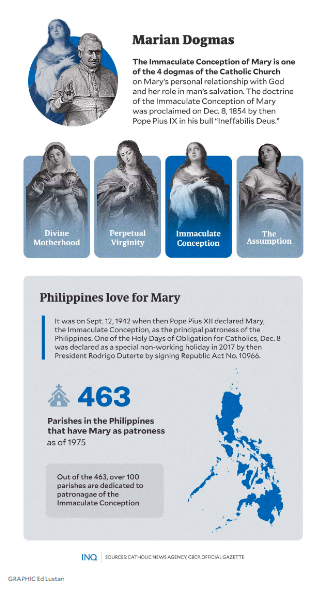Immaculate Conception: What is it and why is it important for Filipinos?

AFP AND STOCK PHOTO
MANILA, Philippines—December 8 is the day to celebrate the Solemnity of the Immaculate Conception of Mary, but there are people who still regard the celebration as the day the Blessed Virgin conceived Jesus, while some take it as the day of Mary’s birth.
Take the case of one nincompoop Twitter user, who asked this: “Dec. 8 nabuntis ang Birheng Maria tapos Dec. 25 siya nanganak (Dec. 8, Mary got pregnant then on Dec. 25, she gave birth to [Jesus]?”
As stated by the Facebook page Millennial Catholics, Dec. 8 is the day when Mary was conceived, while the day when Jesus was conceived is celebrated every March 25, the Feast of the Annunciation.
The Society of Jesus (SJ), through the Ateneo de Manila University, explained that every Dec. 8, “we mark the day of the beginning of the life of Mary in the womb of her mother, St. Anne, nine months before her birthday on Sept. 8.”
RELATED STORY: Feast of Immaculate Conception reminds us to be in state of grace, be holy — Robredo
But why is the conception called “immaculate”?
Looking back, it was on Dec. 8, 1854 when then Pope Pius IX declared in his bull “Ineffabilis Deus” the doctrine of the Immaculate Conception, which is one of the four Marian dogmas of the Catholic Church.
“We declare, pronounce and define that the doctrine which asserts that the Blessed Virgin Mary, from the first moment of her conception, by a singular grace and privilege of almighty God…was preserved free from every stain of original sin is a doctrine revealed by God and, for this reason, must be firmly and constantly believed by all the faithful.”
The SJ said the commemoration “celebrates how God chose and prepared Mary to be the Mother of Jesus even before she was born […] she was conceived without the stain of sin by virtue of the sacrifice of the Son she was to carry.”

“It was so that her Son would not inherit original sin, and being sinless, he could offer himself for the sins of all humanity,” the congregation said last Dec. 5 as it explained why the Catholic Church celebrates Mary’s conception on her mother’s womb.
The SJ said the celebration is a reminder that “if God can preserve Mary from original sin by the offering of Jesus, then all of us can be cleansed from our sins by the same offering.”
Looking back, when the Blessed Virgin appeared to St. Bernadette in Lourdes, France in the year 1858, she introduced herself as the “Immaculate Conception.” The place of the apparition, which the Church has verified to have happened, has since drawn millions of devotees.
Marian teachings
As stated, the Immaculate Conception of Mary is one of the four dogmas of the Catholic Church—doctrines “stating Mary’s personal relationship with God and her role in human salvation.”
- Mary, the Mother of God
Aside from the Immaculate Conception, the four dogmas include Mary’s “Divine Motherhood,” which the Catholic News Agency (CNA) said was proclaimed at the Council of Ephesus in 431.
It said several names are used to describe the Blessed Virgin’s role as the mother of Jesus: “She is called ‘Mother of God,’ which translates the more accurately stated Greek word ‘Theotokos’ or ‘Birthgiver of God.’”
- Perpetual Virginity of Mary
Still based on the explanation of the CNA, the expression of perpetual virginity or ever-virgin refers primarily to the conception and birth of Jesus, stressing that Jesus was conceived by the power of the Holy Spirit only.
The CNA, stating what the Council of Lateran had stressed, said the Blessed Virgin conceived “without any detriment to her virginity, which remained inviolate even after his birth.”
- The Assumption
The doctrine of the Assumption was proclaimed on Nov. 1, 1950 by then Pope Pius XII in his encyclical “Munificentissimus Deus,” stressing that Mary was elevated or assumed into heaven by the power and grace of God.
The CNA explained that based on the dogma, “Mary, Immaculate Mother of God ever Virgin, after finishing the course of her life on earth, was taken up in body and soul to heavenly glory.”
“This definition as well as that of the Immaculate Conception makes not only reference to the universal, certain and firm consent of the Magisterium but makes allusion to the concordant belief of the faithful,” it said.
However, this doctrine has no direct basis in scripture, the CNA said. “It was nonetheless declared ‘divinely revealed,’ meaning that it is contained implicitly in Divine Revelation.”
PH patroness
One of the Holy Days of Obligation observed in the Catholic Church, Dec. 8 was declared as a special non-working holiday in 2017 by then President Rodrigo Duterte by signing Republic Act No. 10966.
READ: Dec. 8, Feast of Immaculate Conception, is special non-working holiday
This, as Mary, the Immaculate Conception, had been declared as the principal patroness of the Philippines on Sept. 12, 1942 by then Pope Pius XII “upon the request of the bishops in the Philippines.”
That law, which made Dec. 8 as a special non-working holiday, originated from the House of Representatives. The House and Senate bills were passed on May 12, 2017 and Dec. 11, 2017, respectively.
In the Senate bill, which was filed by then Sen. Vicente Sotto III, it was stated that the law was needed to allow Filipino Catholics to strengthen their established devotion to Mary by hearing Mass and through the exercise of customary religious activities.
Likewise, one of the manifestations of Filipinos’ veneration to Mary is that apart from festivals in honor of a town’s patron saint, each also has their own claim to the Virgin Mary with a festivity in her honor and vigorously celebrated throughout the year such as the Flores de Mayo, Feast of Nuestra Señora de Peñafrancia, Manaoag Pilgrimage, Obando Fertility Rites, among others.”
The Catholic Bishops’ Conference of the Philippines said the deep love to Mary is also manifested in “novenas to the Blessed Mother as preparation for the patronal feast, the block rosary, and the endless symphony of Marian names in the baptismal records.”
Based on the Catholic Directory in 1975, there are 463 parishes in the Philippines that have Mary as patroness. This, even without counting the thousands of chapels, religious oratories or private shrines dedicated to her.
Out of the 463, over 100 parishes honor the Immaculate Conception, over 60 are dedicated to Our Lady of the Most Holy Rosary, while the rest carry various titles like Assumption of Mary, Our Lady of Mt. Carmel, and Mother of Perpetual Help.
READ: ‘People in love’: Understanding Filipinos’ deep, strong faith in Mary
Based on data from the Augustinians, which is one of the first religious congregations to reach the Philippine islands, they built numerous chapels, sanctuaries and parishes in the Philippines under the patronage of the Immaculate Conception.
The churches included parishes in the cities of Pasig and Malabon, and the provinces of Bulacan, Batangas, Pampanga, Tarlac, Cebu, Iloilo Ilocos Norte, Ilocos Sur, and Abra,
Back in 1945, San Agustin in Intramuros, Manila, the mother church of the Augustinians in the Philippines, was elevated into a parish under the patronage of the Immaculate Conception.
Hard to be sinless?
In a column, Rev. Fr. Roy Cimagala stressed that the Dec. 8 celebration “reminds us of that most wonderful truth of our faith that we all are actually meant to be immaculate, that is, sinless, completely holy which means we are truly and entirely identified with Christ who is holiness himself.”
“We should strive, with God’s grace, to be sinless, always fighting against sin and against anything that can lead us to sin. In a sense, we have to develop a zeal to be immaculate, like Our Lady, which definitely would involve constant struggle against sin and temptations,” he said.
He said while this may be an “impossible pursuit, since we all know that we are all sinners, it should not prevent us from doing our best to struggle to be as sinless as possible.”
“In this regard, we should never forget to develop and strengthen our personal skills in handling temptations. This concern never goes passé, and it touches a basic, indispensable aspect of our life in all levels.”
According to him, temptations can come to us in the subtlest and trickiest of ways. This can be due, at least in part, to the increased level of sophistication both in people’s thinking and in world developments, especially in the area of technology and ideology.
“Truth is, we always need God in our battle against temptations. We should disabuse ourselves from the thought that with our good intentions and our best efforts alone, we can manage to tame the urges of temptations,” Cimagal said.
RELATED STORY: Duterte to Filipinos: Be kind amid trying times
TSB
Disclaimer: The comments uploaded on this site do not necessarily represent or reflect the views of management and owner of Cebudailynews. We reserve the right to exclude comments that we deem to be inconsistent with our editorial standards.
